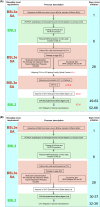Biosafety risk assessment for production of candidate vaccine viruses to protect humans from zoonotic highly pathogenic avian influenza viruses
- PMID: 31659871
- PMCID: PMC7040978
- DOI: 10.1111/irv.12698
Biosafety risk assessment for production of candidate vaccine viruses to protect humans from zoonotic highly pathogenic avian influenza viruses
Abstract
A major lesson learned from the public health response to the 2009 H1N1 pandemic was the need to shorten the vaccine delivery timeline to achieve the best pandemic mitigation results. A gap analysis of previous pre-pandemic vaccine development activities identified possible changes in the Select Agent exclusion process that would maintain safety and shorten the timeline to develop candidate vaccine viruses (CVVs) for use in pandemic vaccine manufacture. Here, we review the biosafety characteristics of CVVs developed in the past 15 years to support a shortened preparedness timeline for A(H5) and A(H7) subtype highly pathogenic avian influenza (HPAI) CVVs. Extensive biosafety experimental evidence supported recent changes in the implementation of Select Agent regulations that eliminated the mandatory chicken pathotype testing requirements and expedited distribution of CVVs to shorten pre-pandemic and pandemic vaccine manufacturing by up to 3 weeks.
Keywords: avian influenza; biosafety; candidate vaccine viruses; influenza vaccine; pandemics; pre-pandemic.
Published 2019. This article is a U.S. Government work and is in the public domain in the USA. Influenza and Other Respiratory Viruses published by John Wiley & Sons Ltd.
Conflict of interest statement
The authors declare no conflict of interest in this review.
Figures

References
-
- US‐HSC . National Strategy for pandemic influenza Implementation Plan. 2006. https://www.cdc.gov/flu/pandemic-resources/pdf/pandemic-influenza-implem.... Accessed March 19, 2018.
-
- US‐DHHS . 2017 Update IV of the HHS pandemic influenza plan. 2017. https://www.cdc.gov/flu/pandemic-resources/pdf/pan-flu-report-2017v2.pdf. Accessed March 19, 2018.
-
- O'Neill E, Donis RO. Generation and characterization of candidate vaccine viruses for prepandemic influenza vaccines. Curr Top Microbiol Immunol. 2009;333:83‐108. - PubMed
-
- Subbarao K, Chen H, Swayne D, et al. Evaluation of a genetically modified reassortant H5N1 influenza A virus vaccine candidate generated by plasmid‐based reverse genetics. Virology. 2003;305(1):192‐200. - PubMed
Publication types
MeSH terms
Substances
Grants and funding
LinkOut - more resources
Full Text Sources
Miscellaneous

